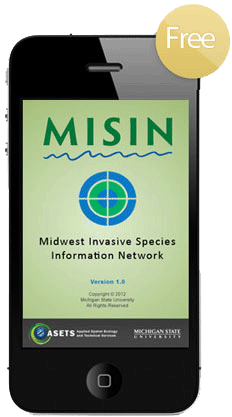
ON THE LOOKOUT FOR INVASIVES
Ever been deer hunting, hiking through the woods, wandering through the city park, kayaking a river, or doing something outside and come across an invasive species and wondered if there was any way to report it without having to go through leaps and bounds to do so? If so the Midwest Invasive Species Information Network (MISIN) app is for you!

MISIN is available for both IPhones and Androids on the APP Store and Google Play for free, and is a new effort in the attempt to aid in early detection and rapid response (EDRR) for invasive species. So if you spend a fair amount of time out in nature, this is an easy app to add to your toolbox and you can become a citizen scientist in the detection of invasive species, and help stop the spread of further non-native plants and animals!
Earlier in the week I was asked to download the app and give it a try. After registering and playing around with MISIN I have found that it’s a great tool if you spot an invasive but I also noticed that the website is a really great resource for species information, recent observations and reports, which they pinpoint and show on satellite maps. Unfortunately that portion isn’t available on the app version. However, when I went running this week I ran to places where observations had been mapped on the website to look for them, and see if I could find them. During my run I managed to find Japanese honeysuckle and black swallow-wort on Michigan State University’s Campus.
The MISIN app is easy and simple to use, with great features including MISIN eNews, which keeps you up to date on the most recent invasive species news, and allows you to search species information to get better familiar with the different non-native plants and animals. I’d recommend registering online, since the app sometimes runs slow, and it’s a great way to get familiar with the layout first.
So as part of your preparations for being outdoors this fall, whether you are bowhunting or steelhead fishing, make sure to register online, download the app, and be on the lookout for invasive species this season!
This early detection and rapid response resource for invasive species is being led by researchers from the Department of Entomology Laboratory for Applied Spatial Ecology and Technical Services from Michigan State University, along with a growing number of other supporting partners that include Michigan’s Department of Natural Resources and Department of Agriculture and Rural Development, Great Lakes Restoration, Shedd The World’s Aquarium, and Michigan Natural Features Inventory.
